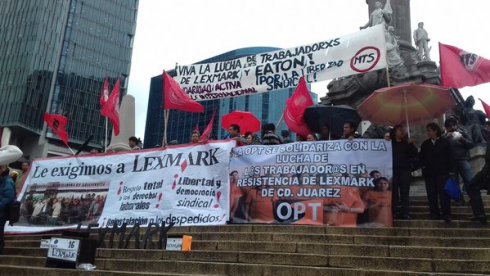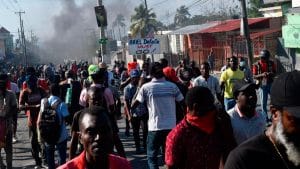Photo from Izquerda Diario, Mexico:
To the workers that held out in occupation
throughout the most important snowfall in 55 years,
for their self-sacrifice and courage.
As written in Bolaño’s fiction, “When one walks through Juárez, you end up being scared of everything. Scared of being beaten up. Scared of being taken away. Scared of torture.” In movies like Denis Villenueve’s Sicario”, released in 2014, Juárez is naturally depicted as the city of drug traffickers, bodies, cuernos de chivo (AK-47s) and hitmen. On top of that, the city that is run by the Institutional Revolutionary Party (PRI) has witnessed a series of murders of social justice fighters between 2011 and 2013.. Among those killed were Susana Chavez, the poet who coined the slogan, #NiUnaMenos(Not One More Woman), and Josefina and Rubén Reyes Salazar, whose cases show the power of paramilitary groups.
However, throughout the past months, Juárez has turned into an epicenter of worker resistance. In November of 2014, workers, especially women, began organizing themselves in the city’s factories.
Alacrane in the 21st Century
Ciudad Juárez is the most industrially dense city in the country according to INEGI’s data, which points out the existence of 300 thousand workers. What is peculiar about this highly-concentrated industry is the severe exploitation of labor: salaries ranging from 90 to 100 pesos a day, 10 to 11 hour work days, sexual harassment within businesses and alienating, repetitive and dehumanizing work.
The city has become a paradise for Foreign Direct Investment since controlling the Confederation of Mexican Workers (CTM) guarantees cheap labor. In 2013 alone, the 15 most important businesses in the area invested $511 (USD). The electronics sector is the most dynamic, especially Flextronics, Electrolux, Honywell, Fire and Luvata. Heading the automobile industry are Hansu, Bosch, OE Quality Friction, Deplhi and LEAR. Most of the investments come from the United States, Japan, Luxemburg, Korea and China.
According to Luis K. Fong, author of Alacrane, the assembly plant is a special phenomenon: “it’s something atypical as a matter of fact, an addictive and efficient venom for any squared mind frame. A defiant and dialectical reality in motion awaiting a resulting specialization, a militant explanation and a viable plan that reverts, modifies and subverts it, as Fito Gallegos, another professional agitator, once said. The workers in that section have a pressing need for change in order to escape their alienation and misery.”
This important concentration of workers is made invisible by the common notion of the “end of the working class” and diluted [or replaced] by concepts such as “people”, “poor”, or “employees”. According to Michel Husson, a French economist, there is a tendency towards the formation of a global working class, but it is “highly segmented due to considerable wage differences and limited mobility while capital is almost entirely free to circulate. Under these conditions, globalization has the effect of having workers compete against each other in any country.” Wage competition diminishes the capacity for resistance and solidarity ties. This tendency has become very apparent in Mexico.
From Occupations to the Strike in Lexmark
It all started at EATON Bussman. Running on Irish resources, this electronics firm has 18 manufacturing plants in the country and 11 thousand workers. On June 9, thirty-five operators in Juárez protested outside the factory demanding an independent labor union, a wage increase and an end to workplace harassment. The movement’s lawyer, Susan Prieto Terrazas, delivered the union’s petition to the Local Conciliation and Arbitration Board (LCAB), but the workers were fired. The following day, the workers began an occupation, demanding their reinstatement.
On August 13, the factory of Scientific Atlanta, which is partnered with the Asian multinational Foxconn, fired 150 workers who had begun to organize an independent union inside the plant. The Chinese company assembles materials for Apple and is well-known for the mass wave of suicides that took place within its Zhengzhou facilities between 2010 and 2013 as workers’ reaction to the alienating and brutalizing work conditions. In 2010, a group of dissident workers of Scientific Atlanta in Juárez set fire to the company’s dining hall, demanding an improvement in working conditions. To this day, these 150 workers are still claiming their reinstatement and have registered their independent union with the LCAB through Susana Prieto Terrazas.
On September 30, at ADC ComssScope in Parque Industrial Antonio J. Bermúdez, 200 workers protested outside the factory to demand a wage increase, an independent union, an end to workplace and sexual harassment and the rehiring of those who were laid off. ADC ComssScope is based in Minneapolis and produces electric cables. In 2010, it claimed $78.5 million (USD) in net income. The workers who protested were fired.
On November 4, at the Lexmark factory that produces ink cartridges located on Independence Boulevard, a group of 60 operators joined the protests at ADC ComssScope, Scientific Atlanta Foxconn and EATON Bussman, demanding that 41-year-old Miguel Ramírez Liévano was fired, along with 28-year-old Perla Yáñez Olivas.
On November 12, almost all of the 400 workers who had been laid off organized a unified protest targeting the Secretariat of Labor and Social Welfare. At the same time, operators of EATON Bussman, Scientific Atlanta Foxconn and ADC ComssScope held occupations outside the companies’ doors, pressuring them to satisfy their demands. The group is very diverse, with workers who have migrated from Veracruz, Chiapas, Guerrero and the State of Mexico. The whole country is immersed in the factory world.
At Lexmark and EATON Bussman, the occupations have kept up despite freezing temperatures. On December 27, the city underwent one of the worst snowfalls in 55 years. Temperatures reached -18° C and the streets were covered with 30 centimeters of snow. It was around that time that the movement transitioned into a new stage when 700 workers carried out a strike during the night shift on December 7.
Susana Prieto Terrazas, who has been the movement’s official lawyer, stated in an interview, “Everyone on the night shift complied with the strike, which demonstrates a great display of solidarity and strength at the factory. The strike was so outstanding that managers, engineers, assembly line leaders and planners had no idea what to do since all production had been halted. Facing complete chaos, they decided to call to be transported out of the plant. Managers kept on telling the workers, ‘We will pay for the day, but leave the factory.’”
The strike kept its fire alive during the next three days – December 8, 9 and 10 – and production came to a halt for four consecutive days. Miriam Delgago, one of the movement’s leaders at Lexmark, said, “The strike gave strength and encouragement to continue fighting and resisting.” Since then, the movement that was sparked at Lexmark, EATON Bussman and Scientific Atlanta Foxconn has expanded.
This new labor movement presents significant challenges for the anti-capitalist left. The working-class struggles in Juárez make up the arsenal of a whole new movement of workers. Even under the CTM’s strong corporate power, factory workers are still setting forth ideas about democratic, combative and class-conscious unions. Even though these cases may express themselves as isolated phenomena at the moment, they stand at the root of the conflict between capital and work in a city with such a high degree of imperialist investment.
A year after the events of Iguala, the labor movement has pushed forward, along with those demanding that the 43 students be found alive. The uprising of workers in San Quintín, the unionism at Honda in Jalisco and Mazda in Querétaro and workers at Grupo Modelo, EATON, Foxconn, Scientific Atlanta, ADC, Triumph Group en Zacatecas and Acerol Mittal are all evidence of the daily need for solidarity and unity in these struggles, which are now making history along with the 4-year-old “witness“ movement of workers at Sandak in Tlaxcala. It is imperative to support the rise of democratic, combative and class-conscious unions in order to fight back against the CTM and the PRI’s corporatism.










